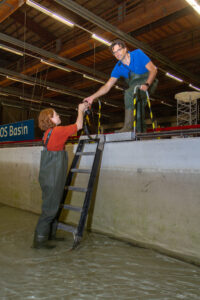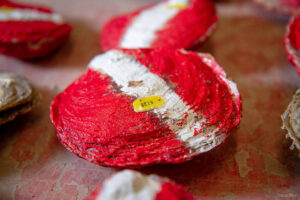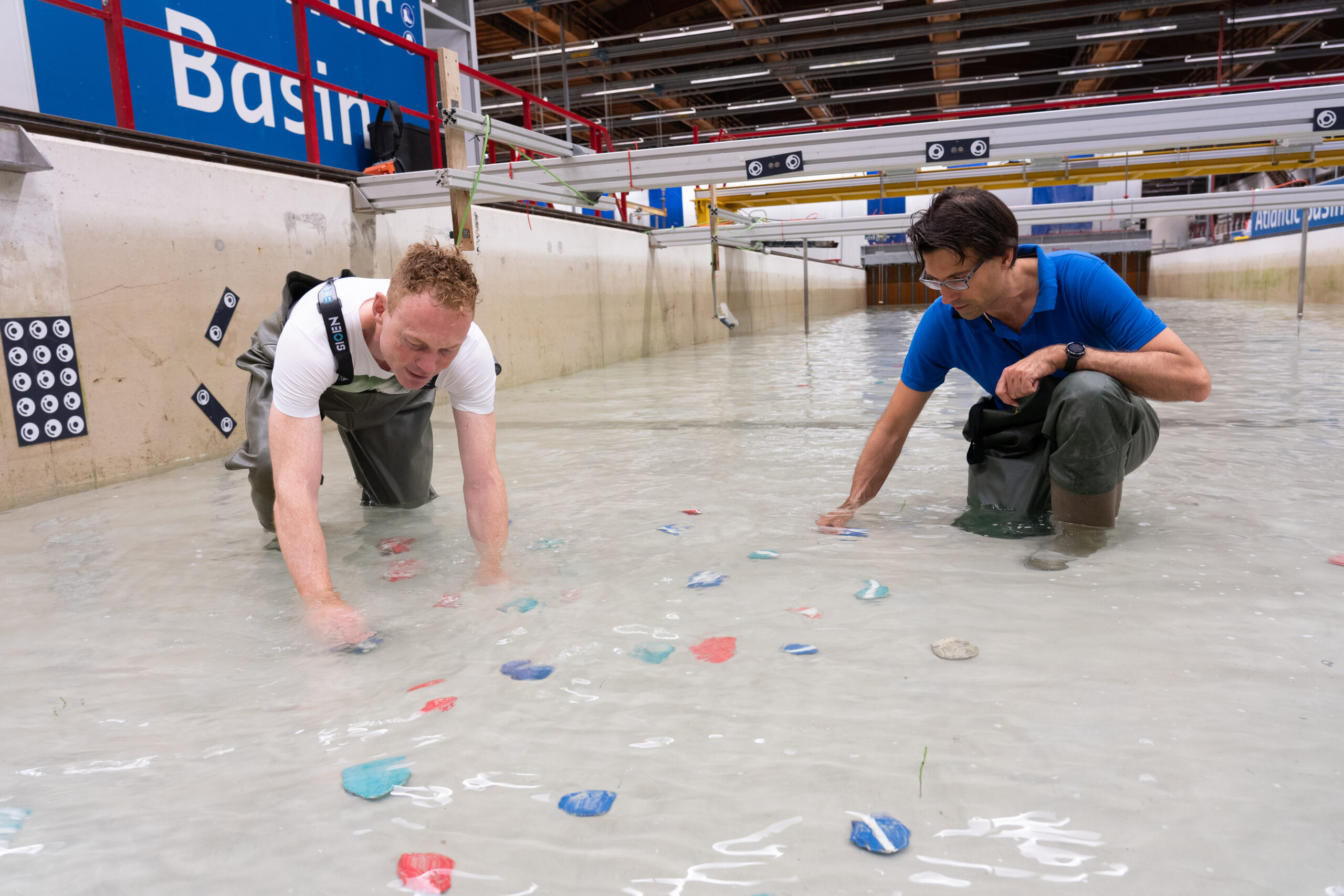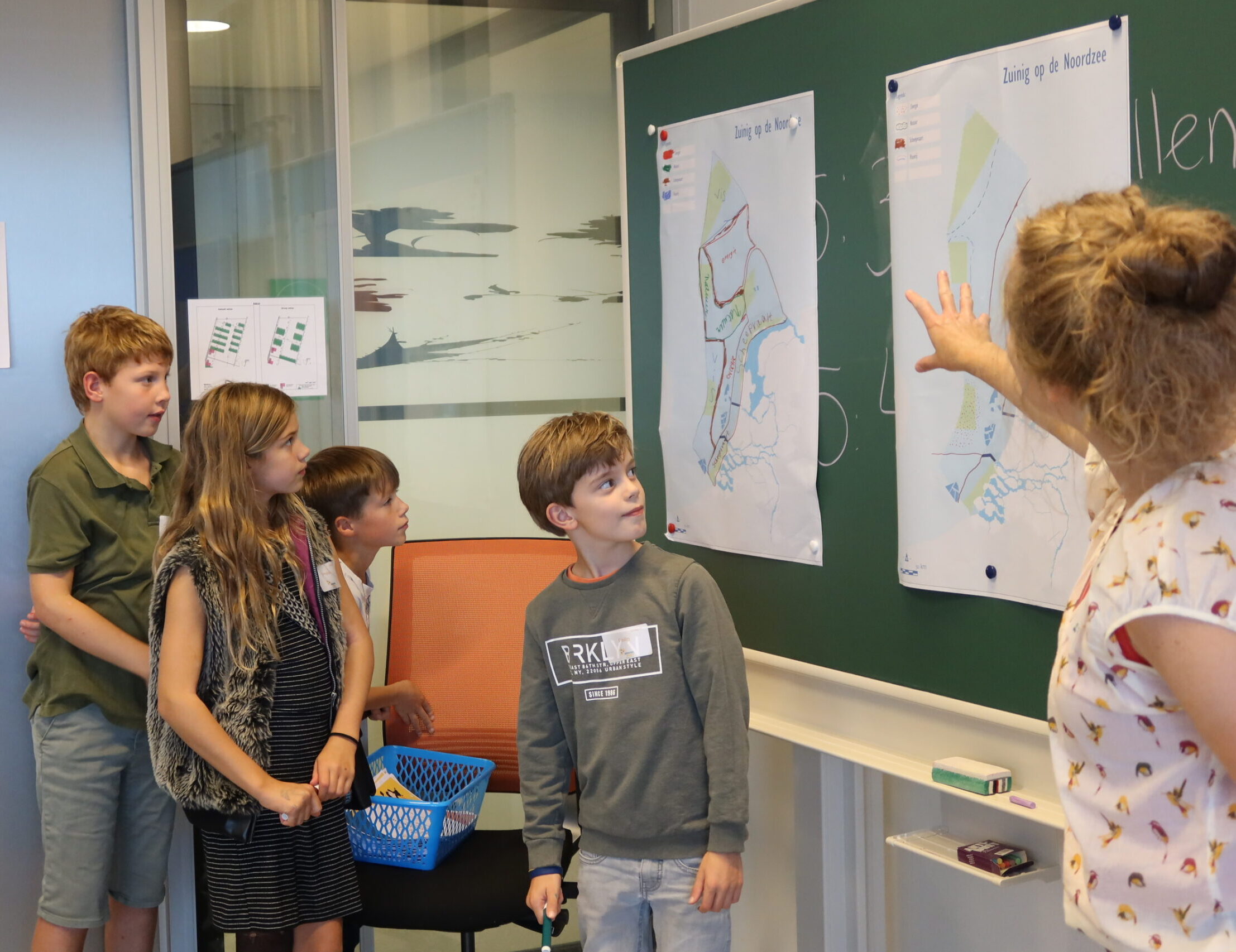Wageningen and Delft researchers are studying how oysters react to currents in a mini-North Sea. Resource spent a day with them.
At the entrance to what looks like a vast factory floor, researchers Oscar Bos, a marine ecologist at Wageningen Marine Research, Tim Raaijmakers, an offshore engineering researcher at Deltares, and I put on our safety shoes. We are at Deltares research institute in Delft, where the two researchers are studying the behaviour of oysters in an enormous wave pool with sand on the floor and a stone ‘dyke’ around the sides.
Machinery buzzes and pumps away in the hall, and we have to talk loudly to be heard above the din. ‘Here we have scale models of various waterworks,’ Raaijmakers explains proudly as we walk over to the Atlantic Basin, an enormous pool of 650 square metres, where the researchers have simulated a mini-North Sea.
In my wading suit I follow Bos and Raaijmakers down rickety steps into the ‘sea’. The water is shallow, and the large suit seems a bit over the top. But then both researchers kneel down in the water and start placing the brightly coloured oysters in neat rows on the sandy floor. They are clearly enjoying themselves. ‘We do most of our work at the computer,’ says Raaijmakers, ‘so a day like this is a nice change.’
A bit later, the three of us are back at the railing of the pool when the alarm goes off: machines start up and before long, the first waves ripple through the water. I must admit, I had expected something a bit more sensational. But instead of a choppy sea, there are gentle waves such as you might see in a sheltered bay. ‘We simulate the current you would find in the deepest water in the North Sea,’ says Raaijmakers. The researchers want to find out how the oysters react to the current they experience in their natural environment.
Restoring oyster banks
This knowledge should help with the restoration of the flat oyster banks (for Ostrea edulis) in the North Sea. The restoration is needed because oyster banks – just like tropical coral reefs – are an important link in the ecosystem. ‘They filter the water and provide a resting place for fish such as plaice and cod,’ says Bos. ‘In turn those fish attract sharks, rays, porpoises and seals.’ Soft corals grow on the shellfish banks, where fish can spawn and birds feed on shrimps and little fish that live around oyster banks. Another function of the oyster banks is to form natural breakwaters that protect the coast.
A century and a half ago, one third of the bed of the Dutch North Sea was covered in flat-oyster banks, says Bos. ‘Through a combination of overfishing, diseases, pollution and cold winters, the flat oyster has now almost entirely disappeared from the North Sea.’ And they don’t come back easily: once there are not many oysters, the chances of successful breeding are small, if only because their sex life is complicated (see inset).
The researchers are working with the shellfish industry within the ECO-Friend project to introduce oysters at offshore wind farms in the North Sea. ‘Offshore wind farms are a suitable location for releasing oysters, partly because those locations are not accessible for bottom-trawling fishing boats.’ Pilot studies are already up and running, including at the Borkumse Stenen, north of Schiermonnikoog island, and the Gemini Wind Farm, north of Groningen.
Washed away
One of the problems faced by the researchers in the field is that it can be impossible to find oysters again after releasing them, so you cannot monitor how they fare. To get a better understanding of what goes on underwater, the researchers are simulating what happens to the oysters on a small scale in the Delft pool. This is what brought Bos and Raaijmakers together. ‘It’s a nice combination of technical and ecological knowledge,’ explains Bos. ‘One of the first things Tim asked me was: what is the size and density of the oysters?
With this model we hope to be able to forecast much more precisely where oysters will end up
That’s not the sort of thing I think about as a biologist.’ Raaijmakers is pleased with the collaboration too. ‘We are interested in nature-inclusive engineering and how that works best. For example, we make scale models of the base of a wind turbine and the seabed protection around it, and then we can see which type of substrate can best be added to it so the oyster larvae can attach themselves to it. Biological knowledge is indispensable for that.’

The nice thing about the test pool is that the researchers can simulate difference conditions to see what effect they have. They sort the oysters by size and shell density. They also add weight to the oysters by filling the shell with little metal balls. Red shells are the lightest, green ones are medium-weight, and the blue ones are the real heavyweights.
Thanks to overfishing, diseases, pollution and cold winters, the flat oyster has almost completely disappeared from the North Sea
A stripe is added to the flat side of the shell, to which the oysters owe their name, so the researchers can see whether the oyster is lying on its flat or its rounded side. If oysters land on their rounded side, they are less streamlined so the current can carry them off more easily.
The surface of the water in the pool is smooth again now, peace has returned and it’s time to see what the ‘damage’ is. Cameras, both underwater and above water, record the situation precisely. Raaijmakers: ‘With this model we hope to be able to forecast much more precisely where oysters will end up, depending on things like the weather conditions when they are released or in the days between their release and the monitoring.’
Fall test

Besides the current, another factor is the height at which the oysters are dropped into the water. At sea, this is done with a kind of crate controlled remotely. So the researchers have created a fall test next to the wave pool. This is basically a large vertical tube of water with which they can establish for every shape and weight of oyster how fast it reaches the bottom of the tube. Some oysters sink like stones, while other float down more like leaves falling off a tree. ‘You can imagine that oysters that take longer to fall will drift further with the current before reaching the seabed,’ says Raaijmakers. ‘We don’t want them all landing in a heap, says Bos, ‘but if they land too far apart, it makes it harder to monitor them, and they won’t be able to breed easily either.’
The researchers expect their first results on a few weeks.
Male and female
The reproduction of the flat oyster is a bit complicated. Oysters start out in life as male. After eight to 10 months in seawater of at least 12 degrees they reach sexual maturity. After three to four years, at water temperatures that gradually go up to 15-16 degrees, they change sex. After that they can switch between sexes. In the mating season (July and August), the males release sperm into the water. The females ‘breathe in’ this sperm through their shell cavity and fertilize their eggs with them. One or two weeks later, they blow the larvae out of their shell. For the first few weeks the larvae swim in the top layer of water and then they sink to the bottom. The baby oyster then needs to find a hard, calcareous surface to attach itself to, and spend the rest of its life there. Only a small percentage of the larvae succeed in this, and the rest die. Flat oysters are fit for consumption after five or six years, but they can live for 20 years and grow to 15 centimetres.

 Oscar Bos (left), a marine ecologist at Wageningen Marine Research, and Tim Raaijmakers, an offshore engineering researcher at Deltares, place oysters in a test pool to see how waves affect the oysters’ location. Photo: Tessa Louwerens
Oscar Bos (left), a marine ecologist at Wageningen Marine Research, and Tim Raaijmakers, an offshore engineering researcher at Deltares, place oysters in a test pool to see how waves affect the oysters’ location. Photo: Tessa Louwerens 

